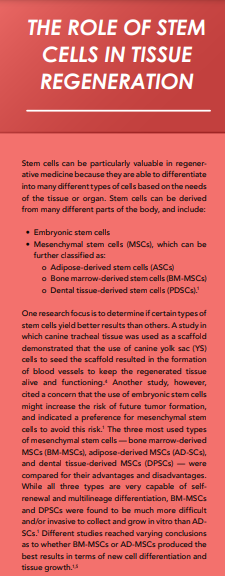Just as stem cell therapy has gone from an experimental concept to an approved and commercially available treatment option for canine patients, bioengineered scaffolds will also likely become available as an advanced modality for dogs in need of tissue replacement.
Advancements in small animal medicine closely follow those made in human medicine. At the same time, dog owners increasingly regard their canine companions as full-fledged members of the family. As a result, the demand for more advanced treatment options for dogs continues to grow. This has, in part, led to the exploration of novel treatments for conditions in which the growth of healthy new tissue or a replacement organ is desired. One such modality involves the creation of biological scaffolds upon which new tissue can grow inside the dogs body. While still in the experimental stages, this type of regenerative medicine is unique in that the bioengineered scaffold is an interactive matrix that can nurture the growth of fully functional tissue in the very location where it is needed.
The goals of tissue engineering
The use of bioengineered scaffolds, sometimes referred to as tissue engineering, relies on advances in the fields of cell biology, developmental biology, bioengineering, and biomaterial science to create new ways to promote healing in animals and humans. Nantavisai et al state that the goals of tissue engineering are to restore, maintain, or improve function of the target tissue or organs.1 Indications can include extensive wounds or fractures, malformed or poorly functioning tissue, and organ failure that requires complete replacement.
In cases of severe tissue damage, or when an organ starts to fail, available treatment options have historically been limited to organ or tissue transplant, tissue grafting, and/or supportive treatment in hopes that the tissue in question will regenerate and/or heal on its own over time. These options have several limitations: tissue and organ transplantation is expensive, donor tissue/organs are not readily available, and transplanting carries the risk of rejection by the recipients immune system. Grafting is not always possible based on a wounds size or location or the availability of suitable tissue to form a graft. Finally, supportive care is not always sufficient for the regeneration and healing of damaged or failing tissue. Efforts to introduce bioengineered tissue aim to address all these concerns.
The bioengineered scaffold
The bioengineered scaffold is meant to emulate the extracellular matrix (ECM) present in all organs and tissues. While acellular, the ECM is still rich in proteins such as collagen and elastin, proteoglycans including chondroitin sulfate, and signaling molecules (ligands) such as nerve growth factor, estrogen, and insulin. These components help provide growing tissue with structure, shape, and support for essential cellular functions.2 Because each tissues biological needs will vary, having a substrate on which to grow can help ensure the new tissue will develop the necessary functionality to integrate with other nearby tissues, and perform the required functions of that specific tissue or organ. Important functions of a bioengineered scaffold include supporting cell adherence, spreading, proliferation, differentiation, maturation, and communication.1
A bioengineered scaffold is typically created by collecting a sample tissue from the type of tissue/organ being targeted from a donor animal or cadaver. In some studies, tissue derived from coral or algae has been used. This tissue must then go through a decellularization process, using a series of reagents and/or high-pressure vacuum treatment; this removes any remaining cells from the tissue to prevent an immune response to the donor matrix in the recipient.1 Synthetic and hybrid (combination of natural tissue samples and synthetic substrates) are also sometimes used. Examples of synthetic scaffolds include ceramic, titanium, and polymers such as poly (lactic-co-glycolic acid) (PLGA). Bioengineered scaffolds and some synthetic scaffolds are termed biodegradable in the sense that they will eventually be broken down and/or remodeled as the new tissue grows in vivo.1,3
Once the scaffold is chosen and prepared, growth factors are added to support the growth of new cells. The scaffold is then seeded with cells, usually stem cells from either the same animal or another one, that will grow to form the basis of the new tissue or organ. The recellularized scaffold is then implanted in the desired location in or on the body, where the cells can grow on the ECM in connection with the surrounding tissues. This allows for more complete incorporation of the new tissue into its target site, complete with the formation of blood vessels, lymphatic pathways, and innervation.1
 Potential applications in the treatment of dogs
Potential applications in the treatment of dogs
The use of bioengineered scaffolds for tissue regeneration has been explored as a treatment option for several disease states and injuries in canine patients. These include:
- Deep or otherwise complex skin wounds
- Bone reconstruction following trauma or tumor excision
- Bladder and urethral reconstruction
- Cartilage reconstruction
- Regeneration of small arteries.6-10
Experimentally bioengineered tissues and organs have also shown value in helping to screen new drugs for safety and efficacy, and thereby identify which drugs should be considered for development and approval.10
Research exploring additional applications for this technology, and to perfect its use so it can be practiced in the clinical setting, is ongoing. Several studies have looked at the use of bioengineered scaffolds in dogs both as a prototype for future treatment options in veterinary medicine, and as a model for possible treatment options in humans. At this time, these applications are still in the early experimental phases and not yet available as treatment options.
- DallOlio et al compared the use of decellularized and recelluarized skin bioscaffolds in the treatment of complex skin wounds in dogs. While they found the fastest healing occurred with the recellularized scaffolds, the decellularized scaffolds also yielded complete healing more quickly than control wounds left to heal by second intention.2 This may pave the way for an easier, less expensive tissue regeneration option for the treatment of skin wounds in dogs.
- Matias et al studied the feasibility of creating recellularized canine trachea scaffolds as a treatment option for patients diagnosed with severe tracheal stenosis and tracheal collapse. A bioengineered tracheal segment, they explain, would be superior to a transplanted segment due to concerns over the immune reaction to foreign tissue. There is also a need for tracheal tissue to retain its secretory and motility functions, and its segmental blood supply, all of which are more easily accomplished when the new tissue can integrate itself seamlessly with the existing tissue. This study did not go so far as to transplant the scaffolds into canine patients, but it measured the degree of immune response to the implantation of tracheal scaffolds in laboratory mice.4
- Yun et al evaluated the success of AD-MSCs (see sidebar on page xx) for the treatment of large bone defects in dogs. The researchers created biodegradable synthetic scaffolds that they seeded with AD-MSCs from donor dogs. These scaffolds were then transplanted into small surgically-created femoral defects in laboratory beagles. The results showed the stem cells could be induced to become osteogenic, and that the femoral defects treated with the seeded bioscaffold had significantly more bone growth in the defect. Conversely, the control group with no treatment filled more of the defect with fibrous tissue. Additionally, because the scaffold was biodegradeable, it did not need to be removed surgically after the bone defect had healed.5
As further research helps refine these technologies, it is almost certain that bioengineered replacement tissue will become a viable treatment option for both humans and animals. Important steps to accomplish this include continuing to elucidate the most effective scaffold materials and the best methods to support the growth of new tissue on the scaffold. Just as stem cell therapy has gone from an experimental concept to an approved and commercially available treatment option for companion animals, bioengineered replacement tissue will likely become available as an advanced modality for dogs and other animals in need of tissue replacement to improve their longevity and quality of life.
________________________________________________________________________
1Nantavisai S, H Egusa, T Osathanon, and C Sawangmake. Mesenchymal stem cell-based bone tissue engineering for veterinary practice. Heliyon 5(2019) e02808.
2DallOlio A, Matias G, Carreira A, Carvalho H, Campanella T, da Silva T, da Silva M, Abreu-Silva A, Miglino, M. Biological Graft as an Innovative Biomaterial for Complex Skin Wound Treatment in Dogs: A Preliminary Report. Materials 2022, 15,6027.
3Qin J, Chen F, Wu P, Sun G. Recent Advances in Bioengineered Scaffolds for Cutaneous Wound Healing. Frontiers in Bioengineering and Biotechnology March 2022 (10) 841583.
4Matias G, Carreira A, Batista V, de Carvalho H, Miglino M, Fratini, P. In vivo biocompatibility analysis of the recellularized canine tracheal scaffolds with canine epithelial and endothelial progenitor cells. Bioengineered 2022 (13) 2: 3551-3565.
5Yun H, Kim S, Park S, Jo W, Kang K, Lee E, Kim D, Jung H, Son J, Park J, Park H, Lee S, Shin H, Hong I, Jeong K. Early Osteogenic-Induced Adipose-Derived Stem Cells and Canine Bone Regeneration Potential Analyzed Using Biodegradable Scaffolds. Bioengineering 2023, 10, 1311.
6Baiguera S, Urbani L, Del Gaudio C. Tissue Engineered Scaffolds for an Effective Healing and Regeneration: Reviewing Orthotopic Studies. BioMed Research International 2014 Article ID 398069.
7Carmagnola D, Tarce M, Dellavia C, Rimondini L, Varoni E. Engineered scaffolds and cell-based therapy for periodontal regeneration. J Appl Biomater Funct Mater 2017, 15(4); e303-e312.
8Culenova M, Bakos D, Ziaran S, Bodnarova S, Varga I, Danisovic L. Bioengineered Scaffolds as Substitutes for Grafts for Urethra Reconstruction. Materials (Basel). 2019 Oct 22;12(20):3449.
9Bousnaki M, Beketova A, Kontonasaki E. A Review of In Vivo and Clinical Studies Applying Scaffolds and Cell Sheet Technology for Periodontal Ligament Regeneration.?Biomolecules. 2022; 12(3):435.?
10National Institutes of Health. Tissue Engineering and Regenerative Medicine. nibib.nih.gov/science-education/science-topics/tissue-engineering-and-regenerative-medicine. Accessed February 10, 2024.


